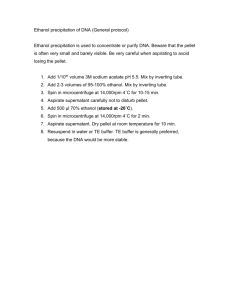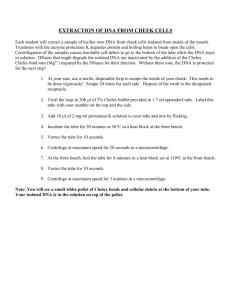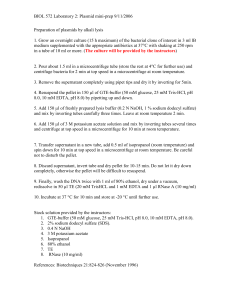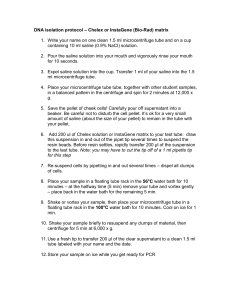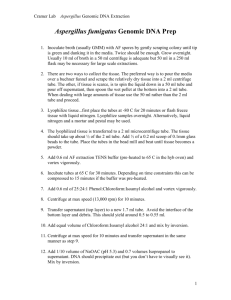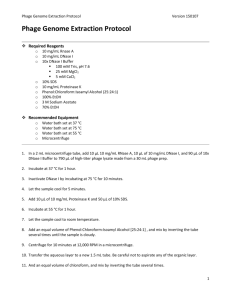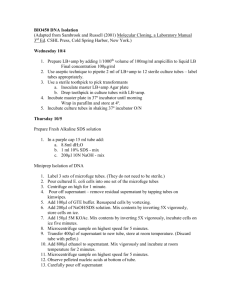DNA Extraction Protocol: Freeze-Thaw Method
advertisement
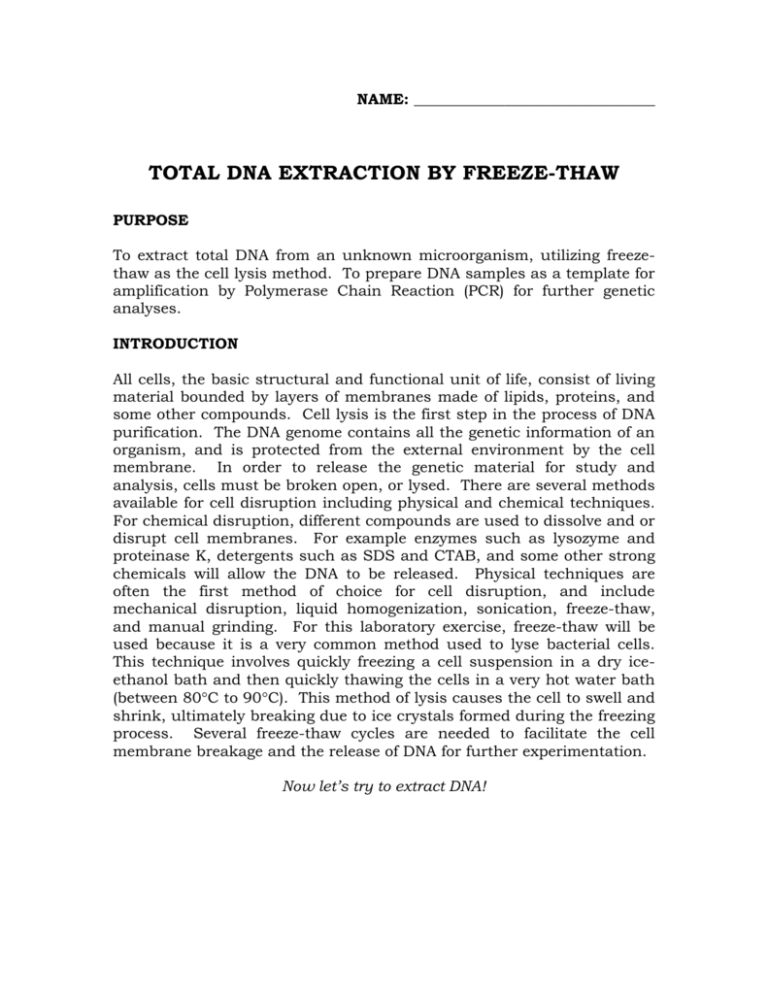
NAME: ________________________________ TOTAL DNA EXTRACTION BY FREEZE-THAW PURPOSE To extract total DNA from an unknown microorganism, utilizing freezethaw as the cell lysis method. To prepare DNA samples as a template for amplification by Polymerase Chain Reaction (PCR) for further genetic analyses. INTRODUCTION All cells, the basic structural and functional unit of life, consist of living material bounded by layers of membranes made of lipids, proteins, and some other compounds. Cell lysis is the first step in the process of DNA purification. The DNA genome contains all the genetic information of an organism, and is protected from the external environment by the cell membrane. In order to release the genetic material for study and analysis, cells must be broken open, or lysed. There are several methods available for cell disruption including physical and chemical techniques. For chemical disruption, different compounds are used to dissolve and or disrupt cell membranes. For example enzymes such as lysozyme and proteinase K, detergents such as SDS and CTAB, and some other strong chemicals will allow the DNA to be released. Physical techniques are often the first method of choice for cell disruption, and include mechanical disruption, liquid homogenization, sonication, freeze-thaw, and manual grinding. For this laboratory exercise, freeze-thaw will be used because it is a very common method used to lyse bacterial cells. This technique involves quickly freezing a cell suspension in a dry iceethanol bath and then quickly thawing the cells in a very hot water bath (between 80C to 90C). This method of lysis causes the cell to swell and shrink, ultimately breaking due to ice crystals formed during the freezing process. Several freeze-thaw cycles are needed to facilitate the cell membrane breakage and the release of DNA for further experimentation. Now let’s try to extract DNA! MATERIALS Latex gloves Dry ice Ethanol (alcohol) Beaker Goggles Unknown culture Microcentrifuge tubes rack Sterile distilled water Plastic container Hot plate or candle warmer Micropipette tips Hot water Microcentrifuge tubes Microcentrifuge Permanent marker Micropipettes PROCEDURE 1. Before beginning be sure to glove your hands in order to prevent contamination. Put on safety glasses. 2. In a beaker or a glass container put some tap water to heat on top of the hot plate or a candle warmer. The water does not have to be boiling, but should be 80C to 90C. 3. While the water is heating up, take the plastic container and put some dry ice in it along with enough ethanol to create a slurry. Make sure that the dry ice is covered with the liquid and that there is space to place the microcentrifuge tubes in the slurry. Caution: Dry ice is cold enough to burn your skin. When handling dry ice, use the kitchen mitts provided. Be sure to keep wearing your eye protection while working with the hot and cold baths. 4. Take the tube with your culture that contains the unidentified bacteria grown on a specific media and place it the microcentrifuge with the purpose to pellet the cells and remove the liquid culture media. Centrifuge the sample for five minutes at the maximum speed. Before you centrifuge your sample make sure that the microcentrifuge has been balanced by placing another tube with the same volume of liquid as your sample tube on the opposite side of the rotor. The microcentrifuge rotor must have an even number of tubes placed one across from the other to create balance. 5. After you have centrifuged your unknown sample discard the supernatant (the liquid that is in the top of the sample tube) by dumping it in an empty container to be discarded properly later. Gently tap the tube on a paper towel to get rid of as much supernatant as possible. Take care not to disturb or dislodge the pellet on the bottom of the tube. 6. After the supernatant has been discarded, resuspend the cell pellet in 500 L of sterile distilled water. Using the 1000 L micropipette, dispense 500 L of the water into your sample tube, close the tube, and mix until you get a homogenized solution. 7. Place the closed tube in the dry ice-ethanol bath using forceps to hold the tube. Keep the tube in the bath for three minutes to freeze. Then quickly place the tube in the hot water bath for three minutes. This process is known as a freeze-thaw cycle. Repeat the same process for a total of three cycles. Make sure that you mix your sample tube between each cycle. 8. After you have completed the three freeze-thaw cycles, proceed to centrifuge your sample tube for five minutes at maximum speed in the microcentrifuge. Again DO NOT FORGET TO BALANCE THE MICROCENTRIFUGE. 9. At this point, be careful not to lose the supernatant. We want to save the supernatant that contains the DNA and discard the pellet that contains cellular debris. Using a micropipette, transfer the supernatant into a new clean, sterile microcentrifuge tube. Now, you are ready to amplify your DNA millions and zillions of times by using the Polymerase Chain Reaction method! QUESTIONS AND CONCLUSIONS 1. Name three other techniques that can be used to lyse cells and release their DNA. * * * 2. Explain briefly the freeze-thaw method. 3. What do you have to do every time you are ready to centrifuge a sample? 4. What does PCR stand for?
